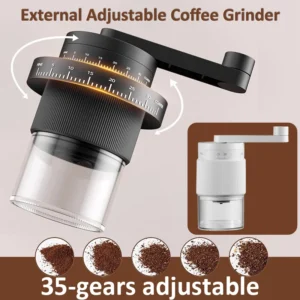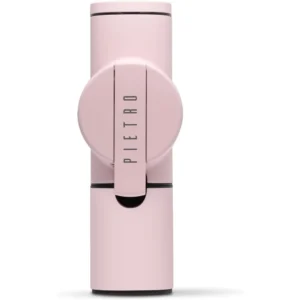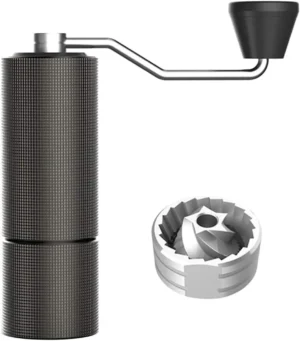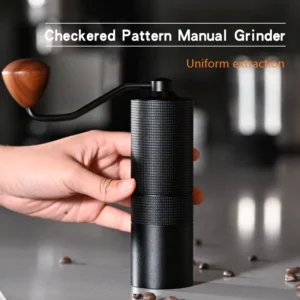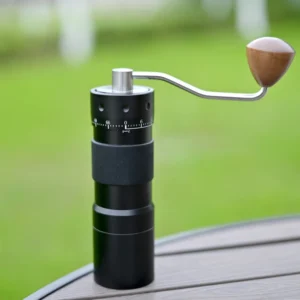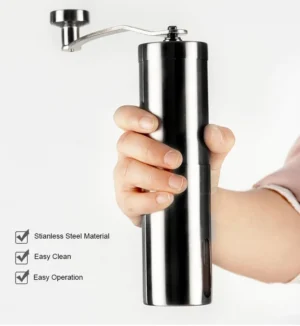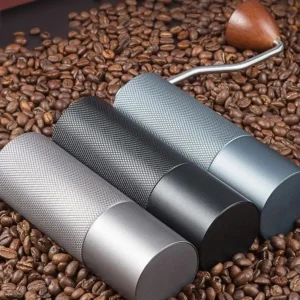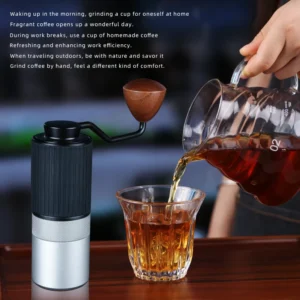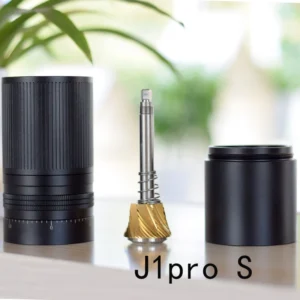Manual Burr Mill
Want truly fresh coffee? Manual burr mills give you consistent grinds, unlocking deep flavor for your best brew yet. Discover your perfect coffee grinder.
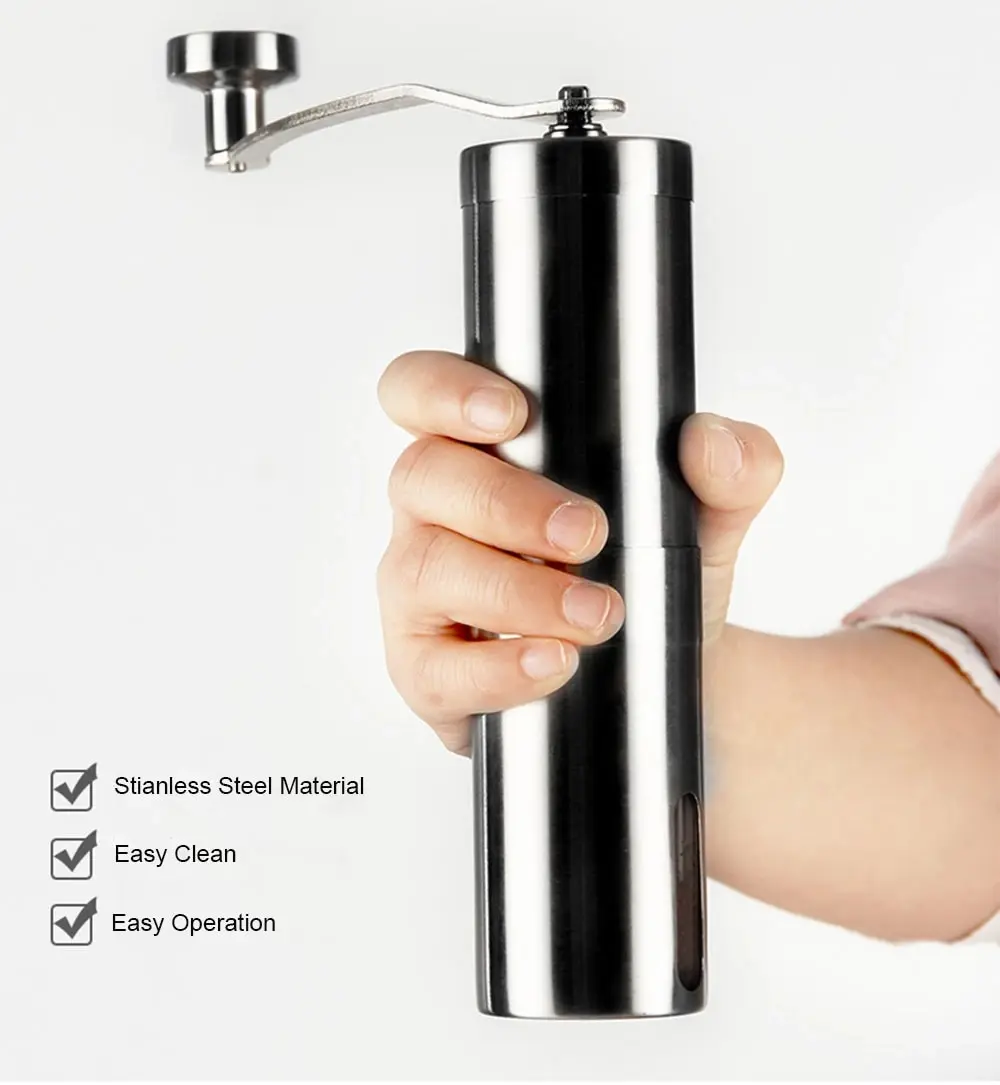
Showing 1–12 of 15 results
Manual Burr Mill, Manual Coffee Grinder Stainless Steel, Manual Coffee Mill Grinder, Mechanical Coffee Grinder
Price range: $127.26 through $130.32 Select options This product has multiple variants. The options may be chosen on the product pageHand Burr Grinder, Manual Burr Mill, Manual Coffee Bean Grinder, Manual Coffee Grinder Stainless Steel
Price range: $90.18 through $94.20 Select options This product has multiple variants. The options may be chosen on the product pageHand Crank Coffee Grinder, Manual Burr Mill, Manual Coffee Bean Grinder
Price range: $2,053.84 through $2,918.42 Select options This product has multiple variants. The options may be chosen on the product pageFine Adjustment Hand Grinder, Hand Burr Grinder, Manual Burr Mill, Manual Coffee Bean Grinder
Price range: $68.86 through $70.72 Select options This product has multiple variants. The options may be chosen on the product pageHand Burr Grinder, Manual Burr Mill, Manual Coffee Bean Grinder, Manual Coffee Grinder Stainless Steel
$221.78 Select options This product has multiple variants. The options may be chosen on the product pageManual Burr Mill, Manual Coffee Bean Grinder, Manual Coffee Grinder for Espresso, Manual Coffee Grinder Stainless Steel
Price range: $151.99 through $178.34 Select options This product has multiple variants. The options may be chosen on the product pageTravel Coffee Grinder, Handheld Coffee Grinder, Manual Burr Mill, Manual Coffee Grinder Stainless Steel
$273.09 Select options This product has multiple variants. The options may be chosen on the product pageHand Crank Coffee Grinder, Manual Burr Mill, Manual Coffee Grinder Stainless Steel
Price range: $204.78 through $228.99 Select options This product has multiple variants. The options may be chosen on the product page
Showing 1–12 of 15 results
The Art of Manual Burr Mills: Premium Coffee Grinding for Connoisseurs
The journey to exceptional coffee begins long before water meets grounds. Manual burr mills represent the pinnacle of coffee grinding precision—the critical tool that preserves the complex flavor symphony locked within each bean. Unlike electric grinders that generate heat through high-speed operation or blade grinders that produce inconsistent particles, a quality burr mill methodically crushes beans to uniform size, protecting the aromatic oils and delicate compounds that define your coffee’s character.
At Savor Suite, we understand that grinding is not merely preparation but the foundation of brewing excellence. The gentle crushing action of premium burr mills releases the bean’s full potential—bright citrus notes, deep chocolate undertones, and delicate floral aromas remain intact rather than being compromised by inconsistent grinding. When each particle extracts at the same rate during brewing, you experience coffee as it was meant to be: balanced, nuanced, and revealing the true terroir of its origin.
Why Coffee Enthusiasts Choose Manual Burr Mills
The discerning coffee lover’s preference for manual burr mills is far from mere nostalgia—it’s rooted in tangible benefits that directly influence what ends up in your cup. The heart of every quality burr grinder is its precision-engineered grinding mechanism, which creates remarkably uniform coffee particles. This consistency is transformative: when water passes through evenly-sized grounds, extraction happens at a synchronized rate, avoiding the bitter over-extraction or sour under-extraction that plagues inconsistent grinds.
Perhaps most crucially, manual grinding operates at a naturally slow speed that generates minimal heat. This matters because heat is the enemy of flavor—even slight temperature increases can prematurely release volatile compounds and oils that should be preserved until brewing. Studies show that uniform particle distribution can improve extraction efficiency by up to 30%, directly translating to cleaner, more defined flavor profiles.
The manual grinding ritual also offers something increasingly rare in our automated world—a moment of mindful connection with your brewing process. The steady resistance of beans being crushed, the aromatic preview of what’s to come, and the satisfying weight of a well-crafted tool in hand all deepen your relationship with coffee. And practically speaking, manual burr mills require no electricity, making them perfect companions for travel, outdoor adventures, or simply keeping your morning ritual uninterrupted during power outages.
Understanding Burr Types and Materials
The heart of any manual grinder lies in its burr design, with two primary configurations dominating the market. Conical burrs feature a cone-shaped center burr that rotates within an outer serrated ring, creating a grinding action that excels at producing consistent medium to coarse grinds ideal for pour-over, French press, and drip methods. Flat burrs, with their parallel grinding surfaces, often create more uniform particle distribution beneficial for espresso’s demanding precision.
Material choice dramatically impacts performance and longevity. Steel burrs offer exceptional sharpness and precision, cutting through beans with minimal resistance and maintaining their edge over years of use. They produce slightly more fines (ultra-small particles) that can contribute body to espresso. Alternatively, ceramic burrs excel in heat management, remaining naturally cool during grinding to further protect volatile flavor compounds. They typically last longer without dulling but can be more brittle if foreign objects enter the grinding chamber.
The difference between premium and average burrs becomes evident in the cup—high-quality burrs maintain micrometer-level manufacturing precision that ensures beans are crushed at exactly the intended size. For perspective, specialty coffee brewing methods may require particle size differences as small as 100 microns between settings (roughly the thickness of a human hair).
Essential Features for Superior Grinding Performance
The distinction between an adequate grinder and an exceptional one lies in its adjustment mechanism, stability, and ergonomics. Premium manual burr mills feature precision-engineered adjustment systems that allow you to dial in your grind with confidence and reproducibility. The finest models offer between 30-50 distinct settings, easily distinguishing between the 200-micron particles ideal for espresso and the 1000-micron coarse grind needed for cold brew.
Stability during grinding significantly impacts consistency—look for models with minimal burr wobble, achieved through precision machining and quality bearings. A stable grinding shaft translates directly to more uniform particles. The finest grinders maintain burr alignment to within 10 microns (1/100th of a millimeter) throughout the grinding process.
Equally important is the physical interface between grinder and user. Ergonomic handle design with sufficient leverage reduces effort and improves consistency, particularly important when grinding the finer settings that create more resistance. Premium grinders balance tactile feedback (letting you feel the grinding process) with efficient operation that won’t leave you exhausted before brewing even begins.
Grind Adjustment Systems
Stepped adjustment systems feature distinct, audible clicks that correspond to specific grind sizes, offering excellent repeatability for those who regularly switch between brewing methods. Most premium stepped grinders provide between 15-40 settings, with each click representing approximately a 50-100 micron change in average particle size.
For ultimate precision, particularly for espresso enthusiasts, stepless adjustment mechanisms allow infinite control within their range. Without fixed positions, you can make micro-adjustments as small as 10 microns—the difference that might transform a good espresso into an exceptional one. This unlimited adjustability proves invaluable when accounting for variables like bean age, humidity, or the subtle differences between coffee origins that may require fine-tuning.
Build Quality and Materials
The materials composing your grinder influence everything from grinding stability to sensory experience. Premium models typically feature bodies crafted from stainless steel, aircraft-grade aluminum, or occasionally hardwoods, prioritizing rigidity that minimizes flex during grinding. This stability directly translates to grind consistency, particularly at finer settings where resistance increases.
Material choices also determine whether your grinder remains a cherished tool for years or decades. Quality stainless steel models typically weigh between 12-24 ounces (340-680g), striking a balance between substantial feel and manageable weight. More compact travel grinders might prioritize lightweight aluminum construction, dropping to 8-10 ounces (227-283g) without sacrificing grinding performance.
Matching Your Brewing Method to the Perfect Grinder
Different coffee preparation methods demand specific particle profiles for optimal extraction. For espresso, seek a grinder with exceptional fine grinding capability and micro-adjustment options, as espresso extraction is remarkably sensitive to even slight grind variations. The best manual grinders for espresso feature stable burrs that produce consistent fines without clogging.
Pour-over devotees should prioritize grinders that excel at medium-fine settings with minimal particle size deviation, allowing for the controlled extraction that highlights clarity and brightness. French press brewing forgives more variation but benefits from grinders that produce clean coarse grounds with minimal fines that might otherwise cause muddiness or bitterness.
AeroPress users enjoy perhaps the most flexibility, but benefit most from grinders with excellent performance in the medium-fine to medium-coarse range. Cold brew requires consistent coarse grinding capacity, ideally from a grinder that can handle larger bean volumes efficiently.
Size and Capacity Considerations
Most premium hand grinders offer capacities between 20-40 grams (approximately enough for 1-2 cups), balancing convenience with manageable grinding effort. Larger capacity models tend to require more force to operate, particularly at finer settings where resistance increases. Consider whether you typically brew single cups or larger batches when selecting capacity.
For those frequently brewing away from home, travel-oriented grinders emphasize compact dimensions without compromising grinding quality. The most portable models measure approximately 6 inches tall by 2 inches wide (15cm × 5cm) and disassemble for convenient packing. Home-focused models might be slightly larger, prioritizing stability and capacity over portability.
Maintenance for Longevity and Performance
Proper maintenance ensures your manual burr mill delivers consistent performance for years. Regular cleaning prevents oil buildup that can turn rancid and taint future brews—for most users, a weekly cleaning regimen suffices. Dry brushing the burrs with a soft brush removes most coffee particles, while more thorough cleaning might require gentle disassembly.
Different burr materials demand specific care: steel burrs can be cleaned with specialized grinder cleaning tablets or uncooked rice in a pinch, while ceramic burrs should never be cleaned with rice (which can cause tiny fractures). Signs that maintenance is needed include increased grinding resistance, inconsistent particle size, or unusual flavors in your coffee.
Pay special attention to the adjustment mechanism during reassembly, as proper alignment is crucial for consistent performance. Quality grinders maintain their calibration even through cleaning cycles, but it’s worth confirming your preferred settings afterward.
Frequently Asked Questions About Manual Burr Mills
Are manual grinders better than electric ones?
For precision and flavor preservation, high-quality manual grinders often outperform electric models in the same price range, offering better burr quality and alignment without generating heat. Electric grinders excel in convenience for multiple consecutive brews.
How long does it take to grind coffee manually?
Grinding 20 grams (enough for a single cup) typically takes 30-90 seconds, depending on the grinder’s efficiency and your selected grind size. Finer settings require more time and effort than coarse grinds.
Can manual burr mills grind fine enough for espresso?
Premium manual burr mills absolutely can achieve espresso-suitable fineness, though not all models perform equally well. Look specifically for grinders that advertise espresso capability and feature precise adjustment mechanisms.
How often do burrs need replacement?
Quality steel or ceramic burrs typically maintain their effectiveness for 500-1,500 pounds of coffee (roughly 5-15 years of daily use for most home brewers). Replacement need is indicated by noticeably inconsistent grinding rather than a strict timeline.
Elevating Your Coffee Journey With the Right Manual Burr Mill
The manual burr mill represents more than merely a tool—it’s the guardian of flavor potential in your brewing ritual. By investing in quality grinding equipment, you’re securing the foundation upon which all great coffee experiences are built. The precision these instruments offer unlocks dimensions of flavor that remain hidden when beans are processed with less care.
At Savor Suite, we believe that the journey toward coffee perfection begins with respecting the bean through precise, thoughtful grinding. Whether you’re brewing delicate single-origin pour-overs or rich, intense espresso, the right manual burr mill transforms potential into experience, turning ordinary moments into sensory discoveries worth savoring.




